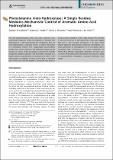Files in this item
Phenylalanine meta-hydroxylase : a single residue mediates mechanistic control of aromatic amino acid hydroxylation
Item metadata
| dc.contributor.author | Gruschow, Sabine | |
| dc.contributor.author | Sadler, Joanna | |
| dc.contributor.author | Sharrat, Peter | |
| dc.contributor.author | Goss, Rebecca Jane Miriam | |
| dc.date.accessioned | 2020-02-14T17:30:05Z | |
| dc.date.available | 2020-02-14T17:30:05Z | |
| dc.date.issued | 2020-02-03 | |
| dc.identifier | 260282409 | |
| dc.identifier | 5ce9a7a3-b3cf-4ab9-b559-79a178d36994 | |
| dc.identifier | 85075424859 | |
| dc.identifier | 000497906200001 | |
| dc.identifier.citation | Gruschow , S , Sadler , J , Sharrat , P & Goss , R J M 2020 , ' Phenylalanine meta -hydroxylase : a single residue mediates mechanistic control of aromatic amino acid hydroxylation ' , ChemBioChem , vol. 21 , no. 3 , pp. 417-422 . https://doi.org/10.1002/cbic.201900320 | en |
| dc.identifier.issn | 1439-4227 | |
| dc.identifier.other | RIS: urn:96A4F8AC13D74EC6321266599CF94FEA | |
| dc.identifier.uri | https://hdl.handle.net/10023/19474 | |
| dc.description | This work was supported by a project grant from the Biotechnology and Biological Sciences Research Council (BBSRC) U. K to R. J. M. G. (BB/I022910/2), and by the European Research Council under the European Union’s Seventh Framework Programme (FP7-3013/ERC grant agreement no 614779 GenoChemetics). | en |
| dc.description.abstract | The rare non-proteinogenic amino acid, meta- L-tyrosine is biosynthetically intriguing. Whilst the biogenesis of tyrosine from phenylalanine is well characterised, the mechanistic basis for meta-hydroxylation is unknown. Herein, we report the analysis of 3-hydroxylase (Phe3H) from Streptomyces coeruleorbidus. Insight from kinetic analyses, of both the wild-type enzyme and key mutants, of the biocatalytic conversion of synthetic isotopically labelled substrates and fluorinated substrate analogues advances understanding of the process by which meta-hydroxylation is mediated, revealing T202 to play an important role. In contrast to the established mechanism of tyrosine biogenesis, which proceeds via NIH shift, our data support direct, enzyme catalysed deprotonation following electrophilic aromatic substitution. We demonstrate that T202 is responsible for this shift in mechanism, with mutation to alanine resulting in a switch to the NIH shift mechanism and loss of regiospecificity. Furthermore, our kinetic parameters for Phe3H show efficient regiospecific generation of meta-L-tyrosine from phenylalanine and demonstrate the enzyme's ability to regiospecifically hydroxylate unnatural fluorinated substrates. | |
| dc.format.extent | 880705 | |
| dc.language.iso | eng | |
| dc.relation.ispartof | ChemBioChem | en |
| dc.subject | Meta-tyrosine biosynthesis | en |
| dc.subject | Hydroxylase | en |
| dc.subject | Enzyme mechanism | en |
| dc.subject | Biocatalysis | en |
| dc.subject | NIH shift | en |
| dc.subject | QD Chemistry | en |
| dc.subject | QH301 Biology | en |
| dc.subject | NDAS | en |
| dc.subject.lcc | QD | en |
| dc.subject.lcc | QH301 | en |
| dc.title | Phenylalanine meta-hydroxylase : a single residue mediates mechanistic control of aromatic amino acid hydroxylation | en |
| dc.type | Journal article | en |
| dc.contributor.sponsor | BBSRC | en |
| dc.contributor.sponsor | European Research Council | en |
| dc.contributor.institution | University of St Andrews. School of Biology | en |
| dc.contributor.institution | University of St Andrews. Biomedical Sciences Research Complex | en |
| dc.contributor.institution | University of St Andrews. School of Chemistry | en |
| dc.contributor.institution | University of St Andrews. EaSTCHEM | en |
| dc.identifier.doi | https://doi.org/10.1002/cbic.201900320 | |
| dc.description.status | Peer reviewed | en |
| dc.identifier.grantnumber | BB/I022910/2 | en |
| dc.identifier.grantnumber | GCGXC | en |
This item appears in the following Collection(s)
Items in the St Andrews Research Repository are protected by copyright, with all rights reserved, unless otherwise indicated.

